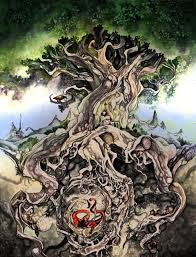In Asgard the Æsir built an immense fortress, in the midst of which lay the Plains of Ida. Here they erected two splendid halls: Gladsheim, which contained high seats for Odin and the twelve peers among the Æsir; and Vingolf, which had high seats for Frigg and the goddesses. Round about Lidskjalf, whence Odin surveys the universe, rose the hall Valaskjalf, roofed with a silver roof.1 The chief of the halls of Asgard, however, was Valhalla, the banquet hall of the Æsir. Here Odin held high festival not only for the Æsir, but for all the translated heroes (einherjar), brave warriors who after death came into his presence. In Valhalla there were 640 portals, through each of which, 960 warriors might march in abreast.
Between heaven and earth the Æsir constructed a bridge called Bifrost, or the Rainbow. The ruddy hue of the bridge is the light of a fire that burns without ceasing to prevent the Giants from crossing over it. Bifrost is of all bridges the most splendid and the strongest, and yet at last it will fall asunder, when the end of all things shall have come.
When the gods held their solemn assemblies, to which came all the Æsir, they resorted to the ash Yggdrasil, the tree of the universe. Here was their principal sanctuary. The ash Yggdrasil spread its branches abroad over the whole world. It had three roots: one among the Æsir, another among the Rime-Thursar, a third in the depths of Niflheim. Beside the root in Niflheim there was a fearsome well, Vergelmir; there lay a dreadful serpent, Nidhogg, which, together with a great number of other serpents, gnawed without respite at the root of the tree, threatening to destroy it. Beside the root that rested with the Rime-Thursar there was also a well, which belonged to a Giant, the wise Mimir; in it lay hidden the highest wisdom, and from it Mimir drank each day. Beside the third root, which stretched out to the Æsir, there was also a well, called Urd’s Well. It was here that the gods held their assembly. Among the branches of the ash many animals had their resort; there were a sagacious eagle, a hawk, four stags, and the little squirrel Ratatosk, which continually ran up and down bearing evil communications between the eagle and Nidhogg.


 Bilingual Vietnamese Fairy Tales
Bilingual Vietnamese Fairy Tales
 Vietnamese Fairy Tales Collection
Vietnamese Fairy Tales Collection
 Shan Hai Jing
Shan Hai Jing
 The 72 Spirits of Solomon
The 72 Spirits of Solomon
Comments
Post a Comment